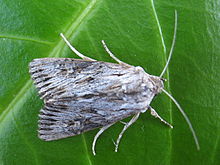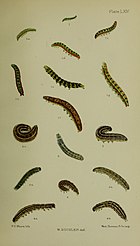332:
306:
lines both strongly dentate, but rarely plain, except as streaks on inner margin; stigmata finely outlined with black, the orbicular narrow, oblique, the reniform broader, both, when clear, with a dark centre; the streak from base on submedian fold brown and indistinct; a brown shade often visible on submedian fold between claviform stigma and outer line; hindwing in male white, in female slightly flushed with brown; for this type form Guenée gives
Provence and Corsica as localities; - ab.
44:
31:
305:
is 36–42 mm. Forewing whitish grey with a slight lilac tinge; the veins darker, the costa, inner margin narrowly, a median shade between the stigmata, some wedge-shaped subterminal blotches in the interspaces before subterminal line, and the dark chequering of the fringe brown; inner and outer
327:
is the
British form, which is nearest the type, but whiter, with all the markings very strongly developed and black in the male, the female pinkish grey; the orbicular stigma varies much in this form from a small round to a long elliptical mark becoming confluent with the reniform. The larva is
310:
ab. nov. is a larger form, with the brown tints of the type replaced by blackish fuscous, the costal area of forewing and the fringe especially darkened; the lines equally indistinct; of this I have seen a pair from Rome, a female marked simply
Germany, and a single male from Amasia: -
328:
yellowish green tinged with reddish above; a pale reddish line along the middle of the back has black V-shaped marks upon it, and there is a series of black marks on each side; the line along the spiracles is yellowish. The head iis green, brown freckled.
667:
810:
726:
427:, Verlag Alfred Kernen, Stuttgart Band 3: Abt. 1, Die Großschmetterlinge des palaearktischen Faunengebietes, Die palaearktischen eulenartigen Nachtfalter, 1914
511:
319:
Frr. is an extreme dark form with the markings in some cases quite lost in the dark suffusion: these last forms are from Greece, Turkey, and Asia Minor; . —
331:
382:
and grasses. The larvae can be found from
October to May. The species overwinters in the larval stage. Pupation takes place under moss or underground.
641:
680:
800:
785:
410:
492:
713:
589:
731:
620:
43:
633:
795:
790:
290:
165:
483:
Robinson, Gaden S.; Ackery, Phillip R.; Kitching, Ian J.; Beccaloni, George W.; Hernández, Luis M. (2010).
805:
547:
685:
594:
148:
602:
780:
534:
286:
174:
38:
672:
752:
705:
757:
695:
739:
466:
378:
315:
Frr. is uniform dark grey, with the inner and outer lines distinct and dentate; —of this
628:
615:
438:
293:
in 1829. It is found in western and southern Europe, North Africa and the Middle East.
774:
347:
there are two generations per year and the flight period is from August to
December.
340:
484:
30:
323:
Stgr., from
Morocco, is also described as having the forewings unicolorous grey; —
718:
654:
95:
570:
125:
105:
343:
adults are on wing from August to
October in one generation per year. In the
282:
115:
75:
55:
581:
564:
391:
302:
744:
646:
344:
659:
85:
65:
541:
330:
278:
607:
545:
335:
1, 1a, 1c young larva 1b, 1d, 1e, 1f, 1g larva after last moult
489:
554:
485:"Search the database - introduction and help"
376:The larvae feed on various plants, including
8:
542:
29:
20:
403:
811:Taxa named by Jean Baptiste Boisduval
520:Lepidoptera and Some Other Life Forms
181:
7:
634:7919f5b3-49a8-46c6-8b3d-5185b90564af
14:
439:"73.230 BF2230 Feathered Brindle
256:Aporophylla australis zeelandica
42:
425:Die Großschmetterlinge der Erde
493:Natural History Museum, London
357:Aporophyla australis australis
1:
390:Coastal areas, olive groves,
362:Aporophyla australis pascuea
827:
180:
173:
154:
147:
39:Scientific classification
37:
28:
23:
801:Moths of the Middle East
786:Moths described in 1829
394:(phrygana), roadsides.
291:Jean Baptiste Boisduval
336:
334:
228:Aporophila australis
220:Xylophasia orientalis
629:Fauna Europaea (new)
556:Aporophyla australis
514:Aporophyla australis
441:Aporophyla australis
423:Seitz, A. Ed., 1914
270:Aporophyla australis
223:Herrich-Schäffer,
158:Aporophyla australis
468:De Vlinderstichting
240:Aporophyla albidior
192:Aporophyla ingenua
516:(Boisduval, 1829)"
443:(Boisduval, 1829)"
337:
285:. The species was
199:Staudinger, 1869
24:Feathered brindle
768:
767:
753:Open Tree of Life
548:Taxon identifiers
366:
275:feathered brindle
266:
265:
260:
252:
244:
243:Bang-Haas, 1906
236:
224:
216:
208:
200:
188:
187:Boisduval, 1829
140:A. australis
818:
761:
760:
748:
747:
735:
734:
722:
721:
719:NHMSYS0000517198
709:
708:
699:
698:
689:
688:
676:
675:
663:
662:
650:
649:
637:
636:
624:
623:
611:
610:
598:
597:
585:
584:
575:
574:
573:
543:
530:
528:
526:
510:Savela, Markku.
497:
496:
480:
474:
473:
464:
458:
457:
455:
453:
434:
428:
421:
415:
408:
365:(Westwood, 1843)
364:
258:
251:Westwood, 1843
250:
242:
234:
231:
222:
214:
206:
204:Xylina scriptura
198:
195:
186:
184:Xylena australis
160:
47:
46:
33:
21:
826:
825:
821:
820:
819:
817:
816:
815:
796:Moths of Europe
791:Moths of Africa
771:
770:
769:
764:
756:
751:
743:
740:Observation.org
738:
730:
725:
717:
712:
704:
702:
694:
692:
684:
679:
671:
666:
658:
653:
645:
640:
632:
627:
619:
614:
606:
601:
593:
588:
580:
578:
569:
568:
563:
550:
524:
522:
509:
506:
501:
500:
482:
481:
477:
471:
465:
461:
451:
449:
436:
435:
431:
422:
418:
409:
405:
400:
388:
379:Silene maritima
374:
367:(Great Britain)
353:
299:
287:first described
248:Agrotis pascuea
235:Bellier, 1862
229:
193:
169:
162:
156:
143:
41:
17:
16:Species of moth
12:
11:
5:
824:
822:
814:
813:
808:
803:
798:
793:
788:
783:
773:
772:
766:
765:
763:
762:
749:
736:
723:
710:
700:
690:
677:
664:
651:
638:
625:
616:Fauna Europaea
612:
599:
586:
576:
560:
558:
552:
551:
546:
540:
539:
536:Lepiforum e.V.
532:
505:
504:External links
502:
499:
498:
475:
459:
429:
416:
412:Fauna Europaea
402:
401:
399:
396:
387:
384:
373:
370:
369:
368:
359:
352:
349:
298:
295:
281:in the family
264:
263:
262:
261:
259:Lempke, 1964
253:
245:
237:
225:
217:
215:Freyer, 1848
212:Xylina ingenua
209:
207:Freyer, 1838
201:
189:
178:
177:
171:
170:
163:
152:
151:
145:
144:
137:
135:
131:
130:
123:
119:
118:
113:
109:
108:
103:
99:
98:
93:
89:
88:
83:
79:
78:
73:
69:
68:
63:
59:
58:
53:
49:
48:
35:
34:
26:
25:
15:
13:
10:
9:
6:
4:
3:
2:
823:
812:
809:
807:
806:Moths of Asia
804:
802:
799:
797:
794:
792:
789:
787:
784:
782:
779:
778:
776:
759:
754:
750:
746:
741:
737:
733:
728:
724:
720:
715:
711:
707:
701:
697:
691:
687:
682:
678:
674:
669:
665:
661:
656:
652:
648:
643:
639:
635:
630:
626:
622:
617:
613:
609:
604:
600:
596:
591:
587:
583:
577:
572:
566:
562:
561:
559:
557:
553:
549:
544:
538:
537:
533:
521:
517:
515:
508:
507:
503:
494:
490:
486:
479:
476:
470:
469:
463:
460:
448:
444:
442:
437:Kimber, Ian.
433:
430:
426:
420:
417:
414:
413:
407:
404:
397:
395:
393:
385:
383:
381:
380:
371:
363:
360:
358:
355:
354:
350:
348:
346:
342:
341:British Isles
333:
329:
326:
322:
318:
314:
309:
304:
296:
294:
292:
288:
284:
280:
276:
272:
271:
257:
254:
249:
246:
241:
238:
233:
226:
221:
218:
213:
210:
205:
202:
197:
190:
185:
182:
179:
176:
172:
167:
161:
159:
153:
150:
149:Binomial name
146:
142:
141:
136:
133:
132:
129:
128:
124:
121:
120:
117:
114:
111:
110:
107:
104:
102:Superfamily:
101:
100:
97:
94:
91:
90:
87:
84:
81:
80:
77:
74:
71:
70:
67:
64:
61:
60:
57:
54:
51:
50:
45:
40:
36:
32:
27:
22:
19:
555:
535:
523:. Retrieved
519:
513:
488:
478:
467:
462:
450:. Retrieved
446:
440:
432:
424:
419:
411:
406:
389:
377:
375:
361:
356:
338:
324:
320:
316:
312:
307:
300:
274:
269:
268:
267:
255:
247:
239:
227:
219:
211:
203:
191:
183:
157:
155:
139:
138:
126:
18:
655:iNaturalist
372:Food plants
297:Description
96:Lepidoptera
781:Aporophyla
775:Categories
706:AporoAustr
472:(in Dutch)
398:References
351:Subspecies
196:britannica
127:Aporophyla
106:Noctuoidea
76:Arthropoda
313:scriptura
283:Noctuidae
166:Boisduval
134:Species:
116:Noctuidae
62:Kingdom:
56:Eukaryota
703:MaBENA:
681:LepIndex
673:11252971
579:BioLib:
571:Q2113674
565:Wikidata
531:Taxonomy
525:June 28,
392:garrigue
386:Biotopes
303:wingspan
175:Synonyms
112:Family:
72:Phylum:
66:Animalia
52:Domain:
758:3209660
732:2560978
647:1760857
452:28 June
447:UKMoths
345:Balkans
339:In the
325:pascuea
321:cinerea
317:ingenua
308:costata
277:, is a
168:, 1829)
122:Genus:
92:Order:
86:Insecta
82:Class:
686:258213
660:483462
621:447967
608:470175
595:213325
273:, the
232:morosa
693:LoB:
668:IRMNG
582:53974
745:9895
727:NCBI
696:5489
642:GBIF
590:BOLD
527:2019
454:2019
301:The
279:moth
230:var.
194:var.
714:NBN
603:EoL
289:by
777::
755::
742::
729::
716::
683::
670::
657::
644::
631::
618::
605::
592::
567::
518:.
491:.
487:.
445:.
529:.
512:"
495:.
456:.
164:(
Text is available under the Creative Commons Attribution-ShareAlike License. Additional terms may apply.

